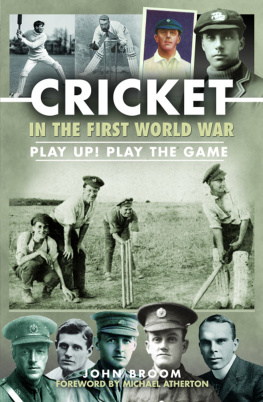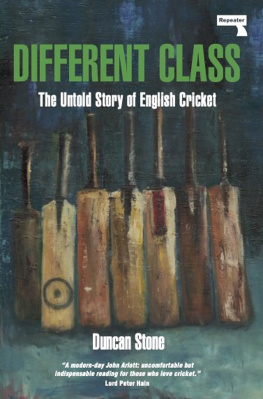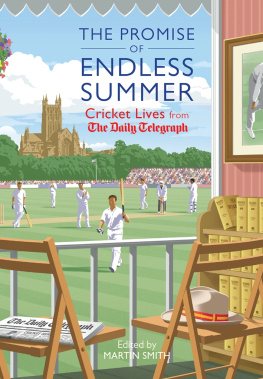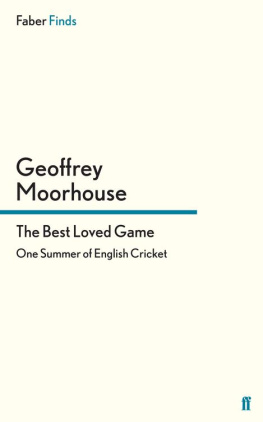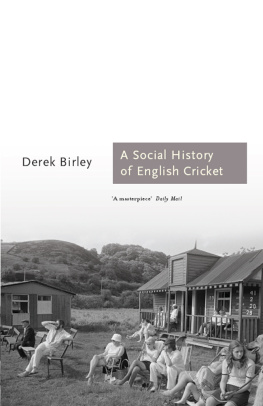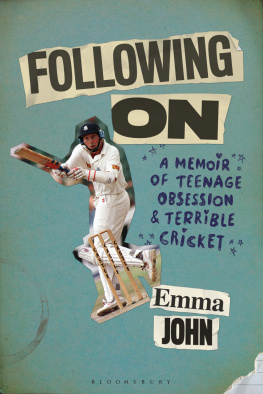ARLOTT, SWANTON AND THE SOUL OF ENGLISH CRICKET

Contents
For more than a quarter of a century after the Second World War, two of the instantly recognisable English voices were commentators at games of cricket. As the BBC tightened its grip on the national consciousness, their voices revealed mannerisms and prejudices that transformed the broadcasting of the nations summer game into a national institution. Each of them drew people into a sport whose complexity was and remains part of its charm. Together they stamped their imprint on a whole social as well as cricketing era.
Both were very capable newspaper journalists, but their fame was based on the way they sounded as broadcasters. John Arlott performed principally on the radio, where his Hampshire burr was the rare sound on the BBC of an English dialect. E. W. (Jim) Swantons commanding voice was associated with his crisp, authoritative summaries of a days Test cricket, on television as well as the radio.
In those post-war years, Englands class system had a slot for almost everyone. Men and women were identified by where they came from, what they read and how they sounded. Within a few minutes of the start of a conversation about cricket, it would be possible to identify the speaker as an Arlott Man or a Swanton Man, and to make a good guess at the speakers education, occupation and politics. Because of their strong personalities and convictions, each had a loyal following.
Swanton was cricket correspondent of the Daily Telegraph. The paper would by the 1960s be known as the Torygraph; its readers were mainly middle-class, and their politics were predictably right of centre. Many followed cricket, too, as players or spectators. A BBC producer specialising in poetry, Arlott became a cricket commentator by a fluke. His personality, and his books on the Test series on which he had commentated, propelled him towards journalism, and eventually he became the cricket correspondent of the Guardian. It had fewer readers than the Telegraph, but it spoke for the liberal centre-left, who admired the style and dash of its sports pages.
Both had a deep and thoughtful love of cricket and cricketers. Swanton, though, was more interested in the grandees of the Marylebone Cricket Club (MCC) at Lords who ran the game, whereas Arlott preferred the company of professional cricketers and never warmed to the toffs at Lords. Both men watched the England cricket team in its rare purple patches and in inglorious defeats; although both wanted to see England win, they cared most about the quality of the cricket and the spirit in which it was played. One more thing they had in common was a detestation of racism in cricket. Swanton once observed that this might surprise Arlott, but it was firmly based on a delight in the West Indies and its cricketers; Arlott loathed racism because of his contempt for apartheid in South Africa. But the most intriguing quality of this story is not so much about what they had in common as on where and how they differed. They were well-defined specimens of two varieties of English life.
Swanton was born into a relatively modest middle-class family, the son of a stockbroker who never quite became something in the City. He boarded at a public school, which he left at the age of seventeen to become a journalist. Arlott was the son of a working-class council employee, educated at state schools until he quit suddenly at sixteen. Not going to university was all their backgrounds had in common. Swantons further education was the job in Fleet Street; Arlott, an autodidact, taught himself very well. He was a published poet with a wide appreciation of literature (his favourite novel was Thomas Hardys Jude the Obscure). He was a sentimental family man who married three times and grieved for the rest of his life after the early deaths of his eldest son and his second wife. Swanton was a bachelor until his early fifties, when he married a widow who was good at golf and whom he delighted in showing off.
Arlott, though he hid it well, suffered from the insecurity of a freelance journalist who never turned down an offer of work in case he might not be asked again. Swanton was utterly secure at the Telegraph, where he was a legendary negotiator of his own salary, generous expenses and secretarial assistance. Both earned a comfortable living. Swanton had an agreeable life-style and was a generous donor to charities. Arlott was a compulsive collector of books, glass, aquatints and wine, who required money to pay for his acquisitions. Arlott was a buyer; Swanton a willing seller when memorabilia came to hand.
The differences between them were deeply embedded. Swanton was a High Churchman, an Anglo-Catholic. Although he wrote a few hymns as a favour to a broadcasting colleague, Arlott had no allegiance to organised religion. Swanton was a Tory; Arlott a Liberal who ran for Parliament. He was for most of his life a strong supporter of the trade union movement, and was president of the professional cricketers union. Swanton was a convivial drinker, and he would have a glass of whisky before his broadcast summary of a days play. Arlott was a heavy drinker whose days almost invariably included at least a couple of bottles of red wine.
Swanton was a rugby football man, Arlott followed association football; each also wrote about their game for their newspapers. Swanton was a self-confessed snob; Arlott liked to think of himself as a man of the people. On the field of play, Swanton became an accomplished amateur cricketer who opened the batting for the club he formed. Arlott lived with the knowledge that his hand/eye coordination left much to be desired, and in his mid-twenties humbly retired from playing any serious cricket. Neither tired of the game, ever.
During the lives of these two cricket writers and broadcasters, England changed. In 1945 it was an old, class-based society, secure in the knowledge of its historic survival and recent victory against Fascism. After the war, it gradually became a more egalitarian society. A generation later, the class system had survived, but it was being defined differently less in terms of social standing, and instead based more on income, wealth and celebrity. This process affected all facets of national life. Nothing was immune, and nothing stayed the same, including professional cricket.
Throughout their active lives, Arlott and Swanton remained loyal to the cricket they had grown up to love. As they approached retirement, they were united in their opposition to the drift, inspired by television, towards the commercialisation that drew cricket away from a summer sport towards the entertainment and leisure industry. Neither man ever grew to like the other; but each had a leading role in the battle for the soul of English cricket.
In 1999, shortly before he died, Jim Swanton wrote for the Daily Telegraph a cheerful account of his life. I was conceived in 1906, the year in which Kent became county champions for the first time, and just about when the left-handed Frank Woolley was starting his wonderful career, it began. By the start of the second paragraph, his childhood was finished. Undeniably, it was a consistent approach. Back in the early 1970s, in a first volume of autobiography entitled Sort of a Cricket Person, he had not mentioned his childhood at all; while later that decade, in Follow On, he had dismissed his childhood as being of no interest: I stick to my contention that in most cases the interval between cradle and adolescence is best taken as read unless it has been in any respect extraordinary. In no respect were Swantons childhood and adolescence extraordinary. Even so, those early years deserve better than just to be taken as read, revealing as they do a startling catalogue of disappointment and underachievement. At his public school, Cranleigh in Surrey, he was not selected to play in either the First XI or the First XV; in the classroom, he was not considered Oxbridge material. His childhood and adolescence were a contradiction of his adult opinion of himself, and he spent the better part of his life determined to show that the early judgements of his worth were incorrect.


